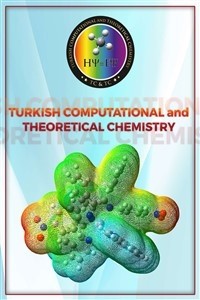Theoretical investigation on electrophilicity indexes and proton affinities of some boron-nitrogen open-chain species
Theoretical investigation on electrophilicity indexes and proton affinities of some boron-nitrogen open-chain species
Theoretical study, Electrophilicity index, Proton affinity Boron-nitrogen open-chain species,
___
- [1] J. Zhang, Q. Shu Li, S. Zhang, Theoretical study on the structures of boron–nitrogen alternant open chain compounds, Journal of Molecular Structure: THEOCHEM 715 (2005) 133–141.
- [2] R. G. Parr, R. A. Donnelly, M. Levy, W. E. Palke, The Journal of Chemical Physics 68 (1978) 3801-3807.
- [3] R. G. Parr, R. G. Pearson, Absolute hardness: companion parameter to absolute electronegativity, J. Am. Chem. Soc. 105 (1983) 7512-7516.
- [4] T. A. Koopmans, Über die Zuordnung von Wellenfunktionen und Eigenwerten zu den Einzelnen Elektronen Eines Atoms, Physica 1 (1933) 104-113.
- [5] R. G. Pearson, The principle of maximum hardness, Accounts of Chemical Research 26 (1993) 250-255.
- [6] R. G. Pearson, Chemical hardness and density functional theory, Journal of Chemical Sciences 117 (2005) 369-377.
- [7] R. G. Parr, L. V. Szentpaly, S. Liu, J. Am. Chem. Soc. 121 (1999) 1922-1924.
- [8] S. Kiyooka, D. Kaneno, R. Fujiyama, Parr’s index to describe both electrophilicity and nucleophilicity, Tetrahedron Letters 54 (2013) 339–342.
- [9] J. E. Huheey, E. A. Keitler, R. L. Keitler, O. K. Mehdi, Inorganic Chemistry, Principles of Structure and Reactivity, Fourth Edition, Pearson, 1993, 223.
- [10] R. D. Dennington II, T. A. Keith, J. M. Millam, GaussView 5.0.8, Wallingford, CT, (2009).
- M. J. Frisch, G. W. Trucks, H. B. Schlegel, G. E. Scuseria, M. A. Robb, J. R. Cheeseman, G. Scalmani, V. Barone, B. Mennucci, G. A. Petersson, H. Nakatsuji, M. Caricato, X. Li, H. P. Hratchian, A. F. Izmaylov, J. Bloino, G. Zheng, J. L. Sonnenberg, M. Hada, M. Ehara, K. Toyota, R. Fukuda, J. Hasegawa, M. Ishida, T. Nakajima, Y. Honda, O. Kitao, H. Nakai, T. Vreven, J. A. Montgomery Jr., J. E. Peralta, F. Ogliaro, M. Bearpark, J. J. Heyd, E. Brothers, K. N. Kudin, V. N. Staroverov, R. Kobayashi, J. Normand, K. Raghavachari, A. Rendell, J. C. Burant, S. S. Iyengar, J. Tomasi, M. Cossi, N. Rega, J. M. Millam, M. Klene, J. E. Knox, J. B. Cross, V. Bakken, C. Adamo, J. Jaramillo, R. Gomperts, R. E. Stratmann, O. Yazyev, A. J. Austin, R. Cammi, C. Pomelli, J. W. Ochterski, R. L. Martin, K. Morokuma, V. G. Zakrzewski, G. A. Voth, P. Salvador, J. J. Dannenberg, S. Dapprich, A. D. Daniels, Ö. Farkas, J. B. Foresman, J. V. Ortiz, J. Cioslowski, D. J. Fox, GAUSSİAN 09, Revision A.02, Gaussian, Inc., Wallingford CT (2009).
- J. A. Pople, R. K. Nesbet, Self‐Consistent Orbitals for Radicals, The Journal of Chemical Physics 22 (1954) 571.
- A. D. Becke, Density‐functional thermochemistry. III. The role of exact exchange, The Journal of Chemical Physics 98 (1993) 5648-5652.
- C. Lee, W. Yang, R. G. Parr, Development of the Colle-Salvetti correlation-energy formula into a functional of the electron density, Physical Review B 37 (1988) 785-789.
- M. J. Frisch, M. Head-Gordon, J. A. Pople, A direct MP2 gradient method, Chemical Physics Letters 166 (1990) 275-280.
- M. Head-Gordon, J. A. Pople, M. J. Frisch, MP2 energy evaluation by direct methods, Chemical Physics Letters 153 (1988) 503-506.
- T.H. Dunning Jr, Gaussian basis sets for use in correlated molecular calculations. I. The atoms boron through neon and hydrogen, The Journal of Chemical Physics 90 (1989) 1007-1023.
- R.A. Kendall, T.H. Dunning Jr, R.J. Harrison, Electron affinities of the first‐row atoms revisited. Systematic basis sets and wave functions, The Journal of Chemical Physics 96 (1992) 6796-6806.
- D.E. Woon, T.H. Dunning Jr, Gaussian basis sets for use in correlated molecular calculations. III. The atoms aluminum through argon, The Journal of Chemical Physics 98 (1993) 1358-1371.
- Ş. Güveli, N. Özdemir, T. Bal-Demirci, B. Ülküseven, M. Dinçer, Ö. Andaç, Quantum-chemical, spectroscopic and X-ray diffraction studies on nickel complex of 2-hydroxyacetophenone thiosemicarbazone with triphenylphospine, Polyhedron 29 (2010) 2393–2403
- [21] K. Sayın, D. Karakaş, Quantum chemical studies on the some inorganic corrosion inhibitors, Corrosion Science 77 (2013) 37-45.
- ISSN: 2587-1722
- Başlangıç: 2017
- Yayıncı: Koray SAYIN
Theoretical Investigation of Temperature Effect on the Formation of Sulphuric Acid Rain
5–Fluorouracil: Computational Studies of Tautomers and NMR Properties
Balasubramanian VISWANATHAN, Ramasamy SHANMUGAM, Arunachalam THAMARAICHELVAN
